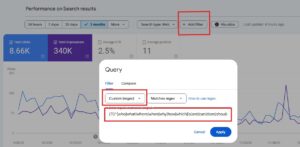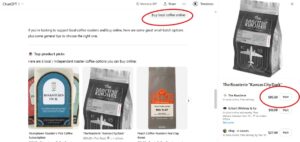If you’re a business trying to get traffic to your website, website copy and content are two important elements that can help you sell your product and improve user experience on your site. Many websites may have an appealing, sophisticated design, but if your copy isn’t up to par, it can affect how well your site performs.
You may be wondering how to write effective website copy that is personalized for your brand. Unfortunately, many businesses make the mistake of only seeing their product from their perspective rather than from the customer’s. Because of this, their website copy isn’t written to work successfully.
In these cases, your business won’t stand out from competitors because your customers aren’t seeing anything they haven’t already seen before. Instead, you should use written website copy to bring in more customers and sell your product. If your copy isn’t converting like you want it to, it’s time to consider a rewrite.
What Is Website Copy?
Copy is mainly used as a mechanism for selling; it guides users through your website’s landing pages by offering information about your brand. This information is usually found on the homepage, about page, product and services pages, and others.
It’s important to make the distinction between copy and content. Copy engages your audience quickly and hooks them into potentially buying your product. Content, on the other hand, is often used for education or Search Engine Optimization (SEO), such as through conversion landing pages, blog posts, and product descriptions.
Not only does copy help you sell your products and services, but it also helps to define your brand’s purpose. Depending on your brand, this typically involves generating sales online, raising brand awareness, convincing people to visit your business’s location, and collecting feedback for how to improve.
Website copy encourages your users to take action, resulting in higher conversion rates for your company’s website.

Why You Need Engaging Website Copy
Besides providing information and increasing conversion rates, web copy is vital for helping search engines understand your website. While design and images do matter for appearance-sake, these two elements have less influence on SEO compared to the effect that copy does.
With quality copy and content that is well-written and published frequently, your website is more likely to be picked up by search engines and ranked higher as an organic search result. When competing against other businesses, it’s important that your brand has a way to stand out from the others.
Web copy also allows you to build a connection with any visitors that come to your site. Engaging copy that’s been carefully thought out can convince your visitors to take action if they know your brand can help them.
It only takes a few seconds for your audience to decide how they feel about your site and whether they’ll stay or go. Copy helps you communicate effectively, brings value to your brand, answers customer questions, and increases trust and authority in your business.
8 Tips on What Makes Good Website Copy
If you’re looking to write engaging copy that converts, there are some elements to consider as you try to sell your product. Take a look at these key tips to ensure that the website copy you’re writing is appropriate and effective for your business’s website.
1. Know Your Customer
To write great copy for your site, you have to understand your customers and keep pace with their personalities. If you know what your customers are looking for or what they need, you can write for them.
Research the tone of your customers so you know what energy to match as you write. If your copy is more directly geared towards who your customers are, they are more likely to convert and see what your brand can offer them.
In order to write for the reader, it’s best to create a persona based on the experiences and feedback of current and past customers. Your existing customers can tell you what they like about your product and how it’s made a difference for them. If you can’t talk to your customers face-to-face, online feedback tools are also very helpful to understand the problems and challenges of your customers.
With a well-researched buyer persona, you will better understand your customers’ language and what they need from you. After gathering feedback, you can shape your website copy to address those problems and convince your customers that your company can offer a solution.
2. Focus on Benefits Rather Than Features
When selling a product, features and benefits tend to go hand-in-hand. However, from the customers’ perspective, benefits far outweigh any features your brand provides. Of course your customers want to know what a product does, but they tend to care more about how it will benefit them in the long run.
Most visitors on your site have a problem they’re looking to find a solution to. Your website’s copy should explain the key advantages your brand offers and how any product benefits will solve your audience’s problems. While your product’s features can do this, it’s more about its benefits overall.
3. Be Concise
Why does web copy need to be easy to read? Unfortunately, most visitors to your site don’t have long attention spans. Because of this, the copy on your website should be straightforward and easy to read. Instead of using a bunch of complex, redundant words, try simpler words that get your point across faster.
If your copy isn’t being read by your audience, it’s basically pointless. Large and long blocks of text look a lot scarier to take on than shorter words and sentences do. Bulky text is too complicated and is bound to scare potential customers away. Your copy should be formatted to be skimmed, so your readers don’t feel like they’re wasting their time.
To break up your website copy and make it easier to read, here are some tips:
- Use Headers: It’s best to break up your copy by using headers and sub-headers. This makes it easier for your customers to read your website copy quickly.
- Use Bullet Points: Another way to break up large chunks of copy is by using bullet points. Large text blocks are harder on the eyes, especially when read on a computer screen or mobile device. Bullet points can help you break up any points you need to make in a format that’s less daunting for the reader.
- Use Short Sentences: There’s no need to use long, complicated wording and phrases to get your point across. Even complex concepts should be explained in an elementary way so your audience can easily understand what you are trying to say.
4. Make Your Copy User-Friendly
User experience is a huge part of making sure your website is successful. With your audience using various means of technology to access your site, you want to ensure your copy is user-friendly. Copy should be scannable and mobile-friendly.
Oftentimes, websites make the mistake of making their design mobile-friendly but not their copy. You’ll want to boost mobile-friendliness as much as possible and adjust the font size to fit mobile devices. Use shorter descriptions, white space, and color shades to differentiate chunks of copy.

5. Give It Personality
Even if your website copy is simple, there are ways to still bring personality to your writing. Clear language and eye-grabbing headlines are a great way to inform and convince customers to buy your product.
Overall, your copy should be compelling and conversational. Instead of talking at your reader, talk to them as if they are in the same room as you.
When you go back to edit your work, search for any phrases that lack tone or excitement. These are places in your copy you’ll want to revise before publishing to ensure your writing has personality.
6. Improve Your Design
Although design shouldn’t be your first priority, it also shouldn’t be ignored. High-quality content needs a decent design to help your readers consume and fully understand what you are trying to say. Overall, you want everything to be visually appealing and enjoyable for your audience.
When it comes to copy, one of the best ways you can enhance its appearance is by choosing the right font. The wrong font selection can make your copy hard to read and cluttered looking, leaving a bad impression on your brand.
The right font will look professional and represent your brand’s personality. When writing website copy, choose your font carefully to make sure your readers have a good experience with your site.
7. Provide a Call to Action
If you can hook your readers with well-written copy, the next step is to get them to take action. Without a Call To Action (CTA), there’s no point in having thorough copy since it wouldn’t lead to conversions. Instead, provide a clear, immediate CTA that encourages your site’s visitors to act quickly.
Because you can’t always count on readers to act on their own, it’s best to add a sense of urgency to your CTA. Creating deadlines can prompt your site’s visitors to take the next step and convert because if they don’t, they’ll lose the opportunity to experience what your brand has to offer.
When adding CTAs to your website copy, consider these suggestions:
- Be Brief: It’s best to keep your CTA to five words or less. If you must write more than five, make sure every word you use is essential for your readers’ understanding.
- Use Action Verbs: Since the purpose of a CTA is to encourage your customers to take action, you’ll want to encourage your audience by using action verbs. For example, “register,” “download,” or “click” are all action verbs that you can start your CTA with. Action verbs help your readers to immediately understand what they’ll be getting if they follow a CTA.
- Incorporate Design: Your CTA doesn’t just have to be text. Use design elements, like shapes or contrasting colors, to help set apart the CTA from your website’s other elements.
8. Test Everything
After publishing copy on your website, it’s best to test it out. If it’s not working effectively, you should consider rewriting your copy as needed.
Writing copy for your website requires both creative and data-driven thinking, so if you’re not seeing how your copy contributes to your website’s conversion rate, it’s time to change it.
At Rank Fuse Digital Marketing, we specialize in content strategy and content development. Our content experts can help to increase your brand awareness by providing effective and high-quality copy and content that convert. For more information, contact us today at 913-270-6770.




